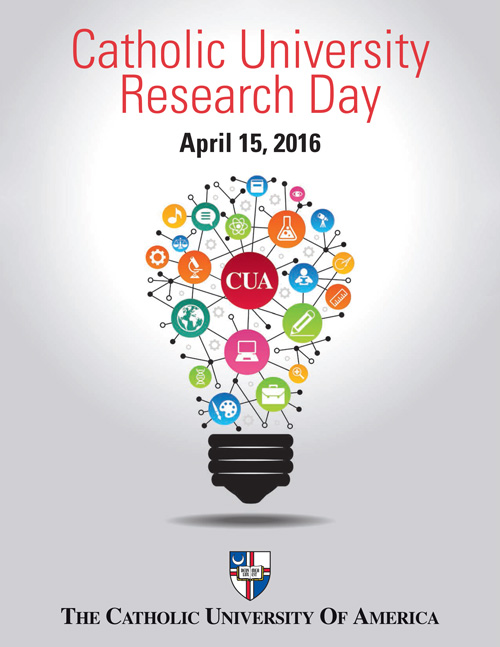

When one thinks of cutting edge university research, test tubes and laboratory coats likely come to mind. But at The Catholic University of America, leaders in scholarly research can be found in all of its 12 schools and 22 research facilities. From the intersection of science and literature to oversized magnetic tweezers to the 50 longest running shows on Broadway: These are just a few of the more than 250 presentations, keynote speeches, and performances that make up the first-ever Catholic University Research Day on Friday, April 15.
As part of the daylong event, students and faculty will give oral presentations on a range of scholarship. Presentations will take place in buildings marked with red and white balloons around the northeast D.C. campus. All classes, except those at the Columbus School of Law, are cancelled that day.
Research Day will highlight serious scholarship, but the presentations will be geared to a general audience, much like a Ted talk—the talks and performances from the TED Conference, where prominent figures deliver remarks in 18 minutes or less. Prizes will be awarded during a ceremony at 4 p.m.
“On this day, the CUA community will be able to showcase the breadth and depth of our community’s scholarship. We delve into fascinating topics across a range of disciplines says Melissa Grady, associate professor of social work and chair of the committee planning the event. “We’ll have a true mix of faculty and students sharing their work.”
Grady notes that the atmosphere on campus that day will be “festive” with musical performances and food trucks stationed near the John K. Mullen of Denver Memorial Library.
Amanda Sheffer, clinical assistant professor of German, will give an oral presentation exploring the intersection of science and literature. Drawing on such classics as Robert Louis Stevenson’s The Strange Case of Dr. Jekyll and Mr. Hyde and Mary Shelley’s Frankenstein, Sheffer’s research explores contemporary works that highlight the intersection of science, technology, innovation, exploration and adventure, and the narrative in new ways.
Sheffer will talk about German-Austrian author Daniel Kehlmann’s 2005 novel Measuring the World (die Vermessung der Welt), which she says “defies characterization as either historical fiction or science fiction.” She says she will explore the larger interdisciplinary implications between the “hard sciences” and the humanities.
“I thought this topic fit nicely with the themes the Research Day organizers were asking for in that they were looking for something to span disciplines — as languages often do,” she adds.
Bridget Dennin, a senior musical theatre major at the Benjamin T. Rome School of Music, says she’s excited about the prospect of displaying her poster presentation on “The 50 Longest Running Shows on Broadway.” Dennin, of Brooklyn, notes that her presentation will examine “what [the shows] have in common, and what makes them stand out.”
More than 80 percent of the 50 shows featured in Dennin’s project are musicals, while only 26 percent are original stories. Dennin says her research was inspired by her job last summer for a Broadway production company in New York as well as her experience attending the 2006 performance of Phantom of the Opera when it became the longest running show in Broadway history.
Dennin, who attends Washington, D.C.’s only university school of music, describes her research as “a good road map to what types of things are successful and well received with audiences … it can help [producers] tailor their shows to what might pique audience interest. Which would in turn lead to more successful and long running shows.”
And what about those magnetic tweezers? Physics doctoral candidate Roberto Fabian Jr. will talk about them as part of his oral presentation titled “Design of Novel Magnetic Tweezers and its Use for Studying DNA-Compacting Proteins.” Using the tweezers, which were developed by the physics department, Fabian and his collaborators can capture a single molecule of DNA and pull it ever so gently.
The tweezers, which are 24 x 24 inches in size and part of a microscope, enable the researchers to measure changes in the length of the DNA molecule. By measuring the molecule, they can perform new types of experiments that enable them to also measure the mechanical properties of DNA and to study how it interacts with individual protein molecules. This helps them to better understand complex biological processes in the cell like chromosome replication, chromosome segregation, DNA recombination, and transcription, Fabian says.
For more information about Research Day, visit http://researchday.cua.edu/res/docs/2016RESEARCHDAYPROGRAM.pdf.
Catholic University has 12 schools (architecture, art and sciences, business and economics, canon law, engineering, law, music, nursing, philosophy, professional studies, social service, and theology and religious studies) and 22 research facilities. Theological College is the national seminary of the University.